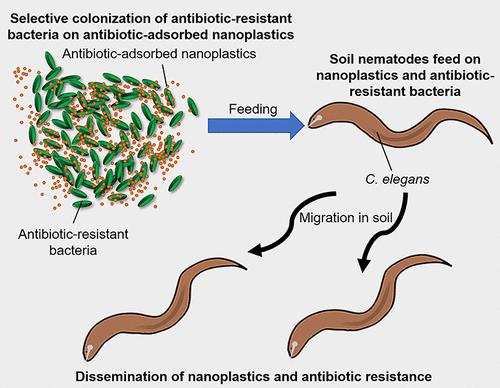当前位置:
X-MOL 学术
›
Environ. Sci. Technol.
›
论文详情
Our official English website, www.x-mol.net, welcomes your
feedback! (Note: you will need to create a separate account there.)
Simultaneous Dissemination of Nanoplastics and Antibiotic Resistance by Nematode Couriers
Environmental Science & Technology ( IF 10.8 ) Pub Date : 2023-06-02 , DOI: 10.1021/acs.est.2c07129 Shepherd Yuen Chan 1 , Sylvia Yang Liu 1 , Rongben Wu 2, 3 , Wei Wei 1 , James Kar-Hei Fang 2, 3, 4, 5 , Song Lin Chua 1, 6, 7, 8
Environmental Science & Technology ( IF 10.8 ) Pub Date : 2023-06-02 , DOI: 10.1021/acs.est.2c07129 Shepherd Yuen Chan 1 , Sylvia Yang Liu 1 , Rongben Wu 2, 3 , Wei Wei 1 , James Kar-Hei Fang 2, 3, 4, 5 , Song Lin Chua 1, 6, 7, 8
Affiliation

|
Nanoplastics (NPs) are increasingly recognized as a newly emerging pollutant in the environment. NPs can enable the colonization of microbial pathogens on their surfaces and adsorb toxic pollutants, such as heavy metals and residual antibiotics. Although the dissemination of plastic particles in water bodies and the atmosphere is widely studied, the dissemination of NPs and adsorbed pollutants on land, via biological means, is poorly understood. Since soil animals, such as the bacterivorous nematode Caenorhabditis elegans (C. elegans), are highly mobile, this raises the possibility that they play an active role in disseminating NPs and adsorbed pollutants. Here, we established that antibiotic-resistant bacteria could aggregate with antibiotic-adsorbed NPs to form antibiotic-adsorbed NP-antibiotic resistant bacteria (ANP-ARB) aggregates, using polymyxins (colistin) as a proof-of-concept. Colistin-resistant mcr-1 bearing Escherichia coli from a mixed population of resistant and sensitive bacteria selectively aggregate with colistin-ANPs. In the soil microcosm, C. elegans fed on ANP-ARB clusters, resulting in the rapid spread of ANP-ARB by the nematodes across the soil at a rate of 40–60 cm per day. Our work revealed insights into how NPs could still disseminate across the soil faster than previously thought by “hitching a ride” in soil animals and acting as agents of antibiotic-resistant pathogens and antibiotic contaminants. This poses direct risks to ecology, agricultural sustainability, and human health.
中文翻译:

线虫传播者同时传播纳米塑料和抗生素耐药性
纳米塑料(NP)越来越被认为是环境中新兴的污染物。纳米粒子可以使微生物病原体在其表面定殖并吸附有毒污染物,例如重金属和残留抗生素。尽管人们对塑料颗粒在水体和大气中的传播进行了广泛的研究,但对纳米粒子和吸附污染物通过生物手段在陆地上的传播却知之甚少。由于土壤动物,例如食菌线虫秀丽隐杆线虫(C. elegans)),具有高度流动性,这增加了它们在传播纳米粒子和吸附污染物方面发挥积极作用的可能性。在这里,我们使用多粘菌素(粘菌素)作为概念验证,确定抗生素耐药细菌可以与抗生素吸附的纳米粒子聚集,形成抗生素吸附的纳米粒子-抗生素耐药细菌(ANP-ARB)聚集体。来自耐药和敏感细菌混合群体的带有粘菌素抗性mcr-1的大肠杆菌选择性地与粘菌素-ANP 聚集。在土壤微观世界中,线虫线虫以 ANP-ARB 簇为食,导致 ANP-ARB 以每天 40-60 厘米的速度在土壤中快速传播。我们的工作揭示了纳米粒子如何通过在土壤动物中“搭便车”并充当抗生素抗性病原体和抗生素污染物的媒介,在土壤中传播的速度比以前想象的更快。这对生态、农业可持续性和人类健康构成直接风险。
更新日期:2023-06-02
中文翻译:

线虫传播者同时传播纳米塑料和抗生素耐药性
纳米塑料(NP)越来越被认为是环境中新兴的污染物。纳米粒子可以使微生物病原体在其表面定殖并吸附有毒污染物,例如重金属和残留抗生素。尽管人们对塑料颗粒在水体和大气中的传播进行了广泛的研究,但对纳米粒子和吸附污染物通过生物手段在陆地上的传播却知之甚少。由于土壤动物,例如食菌线虫秀丽隐杆线虫(C. elegans)),具有高度流动性,这增加了它们在传播纳米粒子和吸附污染物方面发挥积极作用的可能性。在这里,我们使用多粘菌素(粘菌素)作为概念验证,确定抗生素耐药细菌可以与抗生素吸附的纳米粒子聚集,形成抗生素吸附的纳米粒子-抗生素耐药细菌(ANP-ARB)聚集体。来自耐药和敏感细菌混合群体的带有粘菌素抗性mcr-1的大肠杆菌选择性地与粘菌素-ANP 聚集。在土壤微观世界中,线虫线虫以 ANP-ARB 簇为食,导致 ANP-ARB 以每天 40-60 厘米的速度在土壤中快速传播。我们的工作揭示了纳米粒子如何通过在土壤动物中“搭便车”并充当抗生素抗性病原体和抗生素污染物的媒介,在土壤中传播的速度比以前想象的更快。这对生态、农业可持续性和人类健康构成直接风险。











































 京公网安备 11010802027423号
京公网安备 11010802027423号